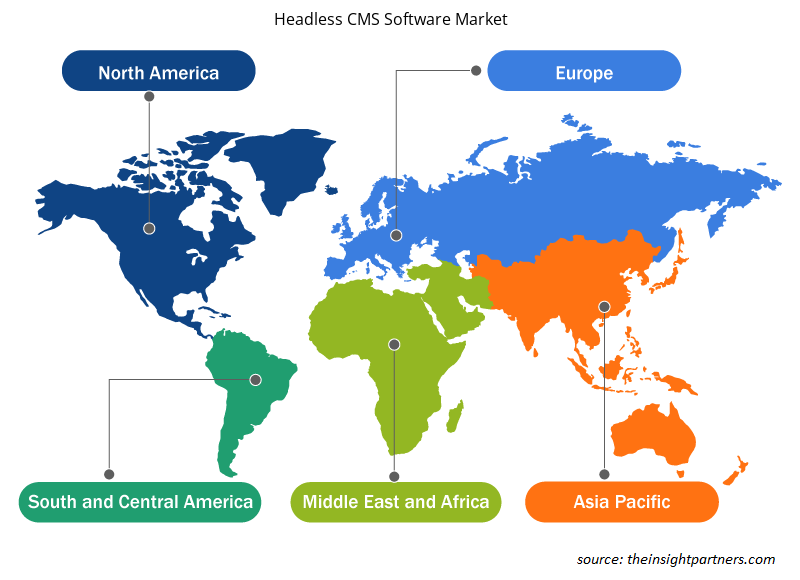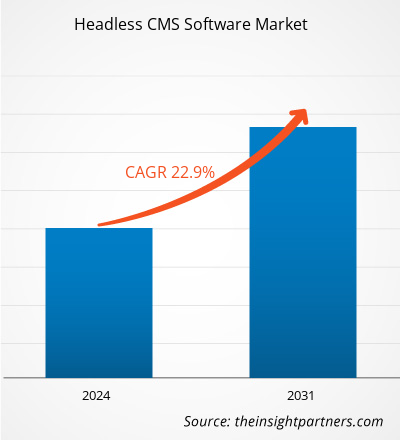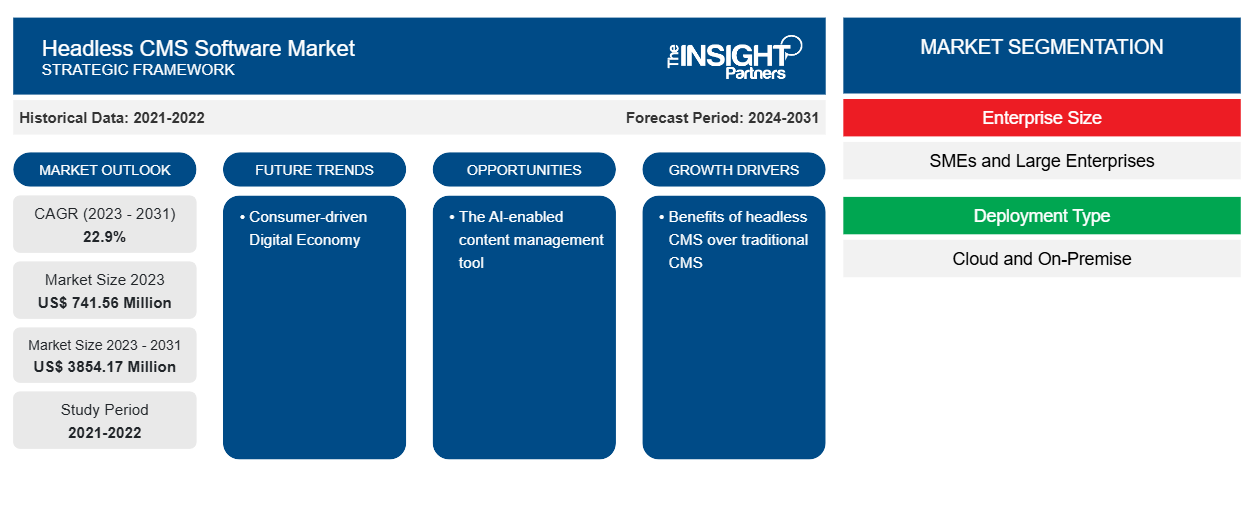预计到 2031 年,无头 CMS 软件市场规模将从 2023 年的 7.4156 亿美元增至 38.5417 亿美元。预计 2023-2031 年市场复合年增长率将达到 22.9%。数字内容的快速增长和基于云的技术的采用可能仍是无头 CMS 软件市场趋势的关键。
无头 CMS 软件市场分析
采用无头 CMS 软件可提高安全性和性能,无头 CMS 可提高灵活性、可扩展性和本地化。这一因素推动了无头 CMS 软件市场的发展。发达国家和发展中国家各行各业对无头 CMS 的需求推动了其市场增长。
无头 CMS 软件市场概览
无头 CMS 是一种内容管理系统,可让您将前端与后端分离。CMS 充当此架构中的内容存储库,并且可以通过 API 将内容部署到多个平台上。无头 CMS 的主要优势之一是其灵活性。对于传统 CMS,前端和后端密不可分,因此对前端的更改会影响对后端的更改,反之亦然。使用无头 CMS,后端与前端分离,允许企业在前端更改其内容和应用程序而不影响后端。
定制此报告以满足您的需求
您可以免费定制任何报告,包括本报告的部分内容、国家级分析、Excel 数据包,以及为初创企业和大学提供优惠和折扣
-
获取此报告的关键市场趋势。这个免费样品将包括数据分析,从市场趋势到估计和预测。
无头 CMS 软件市场驱动因素和机遇
消费驱动的数字经济利好市场
消费者驱动的数字经济已成为各行业数字商务战略的基本组成部分。消费者通过多种渠道接触公司或品牌。这鼓励公司对其数字体验战略进行现代化改造,以提供真正的全渠道体验,满足客户的个性化需求。以客户为中心的内容需要个性化、动态化,并能快速交付。凭借敏捷性、灵活性、可扩展性和个性化的优势,无头 CMS 软件可以帮助公司提升客户体验。
无头 CMS 相较于传统 CMS 的优势
无头 CMS 比传统 CMS 具有更大的灵活性,因为使用无头 CMS,内容只需创建一次。它可以分发到多个渠道和设备,包括网站、智能手表、移动应用程序、物联网设备等。无头 CMS 通过 API 提供内容,其中页面以更快的速度更高效地加载,而使用传统 CMS,每个页面都需要触发服务器端渲染,这会导致加载时间变慢。无头 CMS 比传统 CMS 更安全,因为它们使用先进的云原生技术,并且不会将后端服务器暴露给互联网。因此,无头 CMS 相对于传统 CMS 的这些优势导致了无头 CMS 软件市场的增长。CMS offers greater flexibility over traditional CMS, as with the headless CMS, the content needs to be created once. It can be distributed to multiple channels and devices, including websites, smartwatches, mobile apps, devicesCMS delivers content via APIs where the pages load at a greater speed more efficiently, whereas with the traditional CMS, each page requires trigger a server-side-render, which causes slow load time. Headless CMS is more secure than traditional CMS as they use advanced cloud-native technologies and they don’t expose the backend server to the internet. Thus, such several benefits of headless CMS over traditional CMS lead to the headless CMS software market growth.
无头 CMS 软件市场报告细分分析
有助于得出无头 CMS 软件市场分析的关键部分是墨水部署、组织规模、监控类型和行业。
- 根据部署方式,市场分为本地部署和云部署。预计云部署将以最高的复合年增长率增长。
- 根据企业规模,市场分为中小型企业和大型企业。预计中小型企业的复合年增长率最高。
无头 CMS 软件市场份额按地区分析
无头 CMS 软件市场报告的地理范围主要分为五个地区:北美、亚太地区、欧洲、中东和非洲、南美/南美和中美。
亚太地区预计将以最高的复合年增长率增长。该地区云技术的普及推动了该地区市场的增长。该地区不断增长的中小企业推动了该地区对软件解决方案的需求,推动了合成监测技术的使用。印度和中国等新兴经济体的数字化转型导致各种终端用户行业采用合成监测解决方案。
无头 CMS 软件市场区域洞察
Insight Partners 的分析师已详尽解释了预测期内影响 Headless CMS 软件市场的区域趋势和因素。本节还讨论了北美、欧洲、亚太地区、中东和非洲以及南美和中美洲的 Headless CMS 软件市场细分和地理位置。

- 获取无头 CMS 软件市场的区域特定数据
无头 CMS 软件市场报告范围
| 报告属性 | 细节 |
|---|---|
| 2023 年的市场规模 | 7.4156亿美元 |
| 2031 年市场规模 | 38.5417亿美元 |
| 全球复合年增长率(2023 - 2031) | 22.9% |
| 史料 | 2021-2022 |
| 预测期 | 2024-2031 |
| 涵盖的领域 |
按企业规模
|
| 覆盖地区和国家 |
北美
|
| 市场领导者和主要公司简介 |
|
无头 CMS 软件市场参与者密度:了解其对业务动态的影响
Headless CMS 软件市场正在快速增长,这得益于最终用户需求的不断增长,而这些需求又源于消费者偏好的不断变化、技术进步以及对产品优势的认识不断提高等因素。随着需求的增加,企业正在扩大其产品范围,进行创新以满足消费者的需求,并利用新兴趋势,从而进一步推动市场增长。
市场参与者密度是指在特定市场或行业内运营的企业或公司的分布情况。它表明在给定市场空间中,相对于其规模或总市场价值,有多少竞争对手(市场参与者)存在。
在 Headless CMS 软件市场运营的主要公司有:
- 敏捷公司
- 黄油CMS
- 内容有限公司
- Contentstack 公司
- dotCMS有限责任公司
- 海格拉夫有限公司
免责声明:上面列出的公司没有按照任何特定顺序排列。

- 获取 Headless CMS 软件市场顶级关键参与者概览
无头 CMS 软件市场新闻和最新发展
通过收集主要和次要研究后的定性和定量数据来评估 Headless CMS 软件市场,其中包括重要的公司出版物、协会数据和数据库。以下是市场发展列表:
- 2023 年 6 月,Vsourz 产品系列的最新成员 aurastride 旨在通过推出尖端的无头 CMS 平台来颠覆旅游业。这一创新解决方案将改变旅游企业管理内容和提供个性化体验的方式,同时还能与备受赞誉的 moonstride 旅游行业 SAAS 平台无缝集成。(来源:moonstride,新闻稿,2023 年)
无头 CMS 软件市场报告覆盖范围和交付成果
“无头 CMS 软件市场规模和预测(2021-2031 年)”报告对市场进行了详细分析,涵盖以下领域:
- 范围内涵盖的所有主要细分市场的全球、区域和国家层面的市场规模和预测
- 市场动态,如驱动因素、限制因素和关键机遇
- 未来主要趋势
- 详细的 PEST/波特五力分析和 SWOT 分析
- 全球和区域市场分析涵盖关键市场趋势、主要参与者、法规和最新市场发展
- 行业格局和竞争分析,涵盖市场集中度、热点图分析、知名参与者和最新发展
- 详细的公司简介
- 历史分析(2 年)、基准年、预测(7 年)及复合年增长率
- PEST和SWOT分析
- 市场规模、价值/数量 - 全球、区域、国家
- 行业和竞争格局
- Excel 数据集
近期报告
相关报告
客户评价
购买理由
- 明智的决策
- 了解市场动态
- 竞争分析
- 客户洞察
- 市场预测
- 风险规避
- 战略规划
- 投资论证
- 识别新兴市场
- 优化营销策略
- 提升运营效率
- 顺应监管趋势























 获取免费样品 - 无头CMS软件市场
获取免费样品 - 无头CMS软件市场